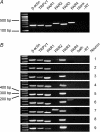Thrombin and trypsin directly activate vagal C-fibres in mouse lung via protease-activated receptor-1
- PMID: 20142268
- PMCID: PMC2853003
- DOI: 10.1113/jphysiol.2009.181669
Thrombin and trypsin directly activate vagal C-fibres in mouse lung via protease-activated receptor-1
Abstract
The nature of protease-activated receptors (PARs) capable of activating respiratory vagal C-fibres in the mouse was investigated. Infusing thrombin or trypsin via the trachea strongly activated vagal lung C-fibres with action potential discharge, recorded with the extracellular electrode positioned in the vagal sensory ganglion. The intensity of activation was similar to that observed with the TRPV1 agonist, capsaicin. This was mimicked by the PAR1-activating peptide TFLLR-NH(2), whereas the PAR2-activating peptide SLIGRL-NH(2) was without effect. Patch clamp recording on cell bodies of capsaicin-sensitive neurons retrogradely labelled from the lungs revealed that TFLLR-NH(2) consistently evokes a large inward current. RT-PCR revealed all four PARs were expressed in the vagal ganglia. However, when RT-PCR was carried out on individual neurons retrogradely labelled from the lungs it was noted that TRPV1-positive neurons (presumed C-fibre neurons) expressed PAR1 and PAR3, whereas PAR2 and PAR4 were rarely expressed. The C-fibres in mouse lungs isolated from PAR1(-/-) animals responded normally to capsaicin, but failed to respond to trypsin, thrombin, or TFLLR-NH(2). These data show that the PAR most relevant for evoking action potential discharge in vagal C-fibres in mouse lungs is PAR1, and that this is a direct neuronal effect.
Figures



Similar articles
-
Subtypes of vagal afferent C-fibres in guinea-pig lungs.J Physiol. 2004 May 1;556(Pt 3):905-17. doi: 10.1113/jphysiol.2003.060079. Epub 2004 Feb 20. J Physiol. 2004. PMID: 14978204 Free PMC article.
-
Evidence for both adenosine A1 and A2A receptors activating single vagal sensory C-fibres in guinea pig lungs.J Physiol. 2006 Sep 1;575(Pt 2):481-90. doi: 10.1113/jphysiol.2006.109371. Epub 2006 Jun 22. J Physiol. 2006. PMID: 16793905 Free PMC article.
-
Activation of bronchopulmonary vagal afferent nerves with bradykinin, acid and vanilloid receptor agonists in wild-type and TRPV1-/- mice.J Physiol. 2004 Feb 15;555(Pt 1):115-23. doi: 10.1113/jphysiol.2003.054890. Epub 2003 Nov 21. J Physiol. 2004. PMID: 14634201 Free PMC article.
-
How the protease thrombin talks to cells.Proc Natl Acad Sci U S A. 1999 Sep 28;96(20):11023-7. doi: 10.1073/pnas.96.20.11023. Proc Natl Acad Sci U S A. 1999. PMID: 10500117 Free PMC article. Review.
-
Functional morphology and physiological properties of bronchopulmonary C-fiber afferents.Anat Rec A Discov Mol Cell Evol Biol. 2003 Jan;270(1):17-24. doi: 10.1002/ar.a.10005. Anat Rec A Discov Mol Cell Evol Biol. 2003. PMID: 12494486 Review.
Cited by
-
Vagal Afferent Innervation of the Airways in Health and Disease.Physiol Rev. 2016 Jul;96(3):975-1024. doi: 10.1152/physrev.00039.2015. Physiol Rev. 2016. PMID: 27279650 Free PMC article. Review.
-
Subepithelial trypsin induces enteric nerve-mediated anion secretion by activating proteinase-activated receptor 1 in the mouse cecum.J Physiol Sci. 2012 May;62(3):211-9. doi: 10.1007/s12576-012-0198-7. Epub 2012 Mar 3. J Physiol Sci. 2012. PMID: 22389134 Free PMC article.
-
Acid sensitivity of the spinal dorsal root ganglia C-fiber nociceptors innervating the guinea pig esophagus.Neurogastroenterol Motil. 2015 Jun;27(6):865-74. doi: 10.1111/nmo.12561. Epub 2015 Apr 5. Neurogastroenterol Motil. 2015. PMID: 25846134 Free PMC article.
-
Endothelial Protein C Receptor (EPCR), Protease Activated Receptor-1 (PAR-1) and Their Interplay in Cancer Growth and Metastatic Dissemination.Cancers (Basel). 2019 Jan 8;11(1):51. doi: 10.3390/cancers11010051. Cancers (Basel). 2019. PMID: 30626007 Free PMC article. Review.
-
SARS-CoV-2 papain-like protease activates nociceptors to drive sneeze and pain.bioRxiv [Preprint]. 2024 Jan 11:2024.01.10.575114. doi: 10.1101/2024.01.10.575114. bioRxiv. 2024. PMID: 38260476 Free PMC article. Preprint.
References
-
- Amadesi S, Nie J, Vergnolle N, Cottrell GS, Grady EF, Trevisani M, Manni C, Geppetti P, McRoberts JA, Ennes H, Davis JB, Mayer EA, Bunnett NW. Protease-activated receptor 2 sensitizes the capsaicin receptor transient receptor potential vanilloid receptor 1 to induce hyperalgesia. J Neurosci. 2004;24:4300–4312. - PMC - PubMed
-
- Ashitani J, Mukae H, Arimura Y, Matsukura S. Elevated plasma procoagulant and fibrinolytic markers in patients with chronic obstructive pulmonary disease. Intern Med. 2002;41:181–185. - PubMed
-
- Barry GD, Le GT, Fairlie DP. Agonists and antagonists of protease activated receptors (PARs) Curr Med Chem. 2006;13:243–265. - PubMed
-
- Carr MJ, Schechter NM, Undem BJ. Trypsin-induced, neurokinin-mediated contraction of guinea pig bronchus. Am J Respir Crit Care Med. 2000;162:1662–1667. - PubMed
Publication types
MeSH terms
Substances
LinkOut - more resources
Full Text Sources
Other Literature Sources
Molecular Biology Databases
Miscellaneous

